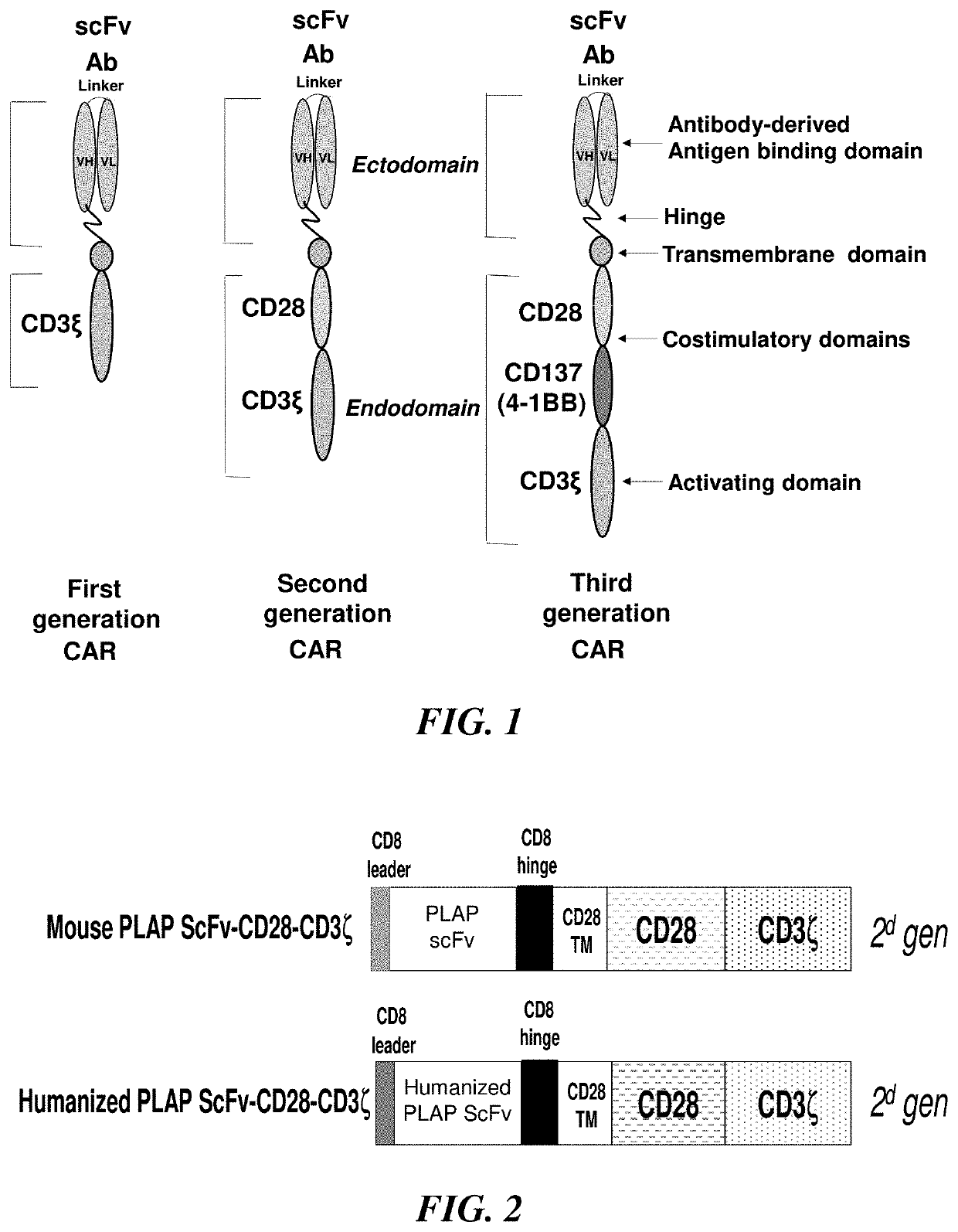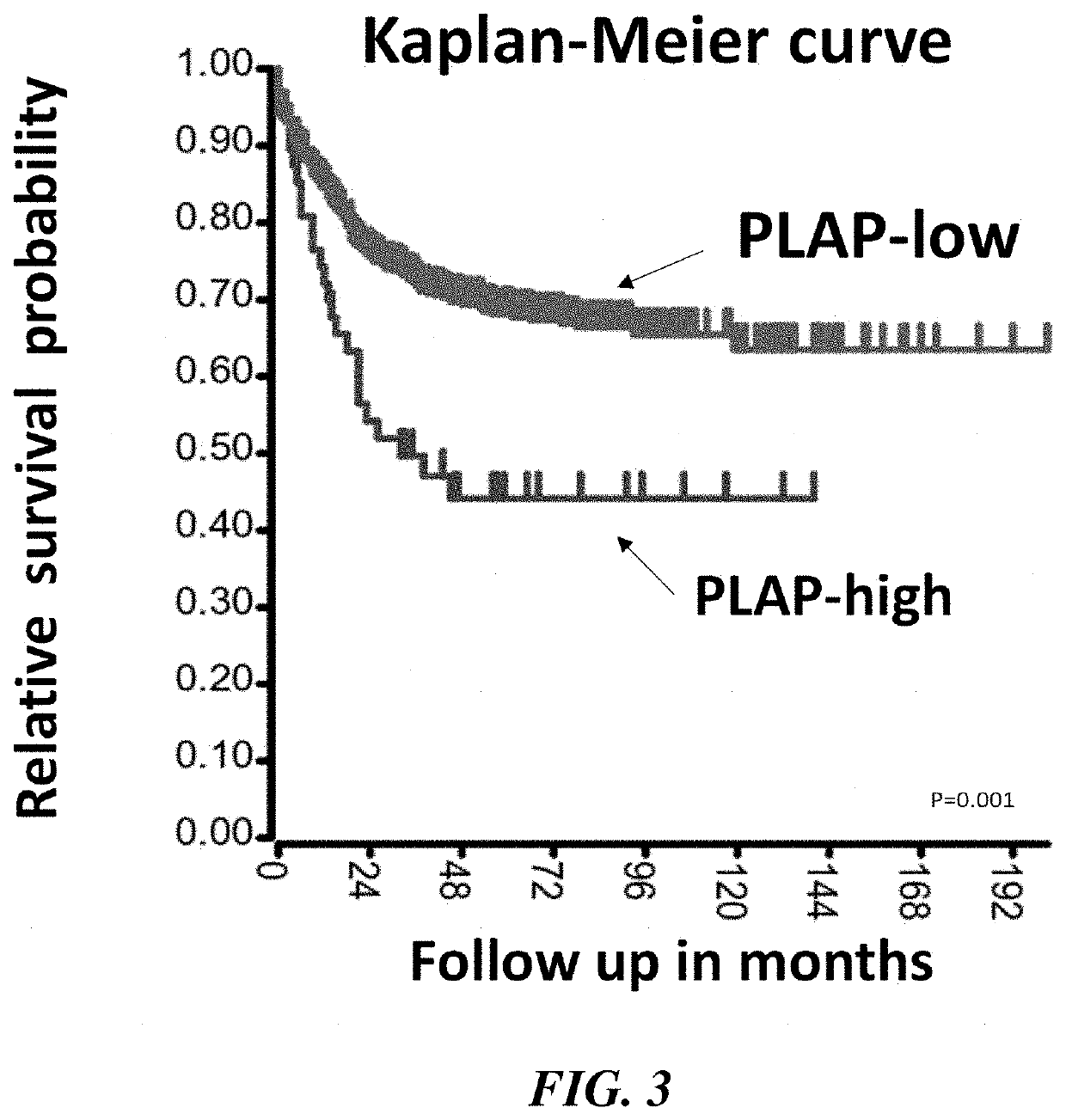Plap-car-effector cells
- Summary
- Abstract
- Description
- Claims
- Application Information
AI Technical Summary
Benefits of technology
Problems solved by technology
Method used
Image
Examples
example 1
and Methods
Cells and Culture Medium
[0062]HEK293FT cells from AlStem (Richmond, Calif.) were cultured in Dulbecco's Modified Eagle's Medium (DMEM) plus 10% FBS and 1% penicillin / streptomycin. Human peripheral blood mononuclear cells (PBMC) were isolated from whole blood obtained from the Stanford Hospital Blood Center, Stanford, Calif. according to IRB-approved protocol using Ficoll-Paque solution (GE Healthcare). Colon cancer cell lines: PLAP-negative: SW620, HT29, HCT116 and PLAP-positive: Lovo, Caco-2, LS123 were obtained from Dr. Walter Bodmer (Oxford, UK), whose laboratory authenticated cell lines using SNPs, Sequenom MassARRAY iPLEX and HumanOmniExpress-24 BeadChip arrays, and tested for the absence of Mycoplasma as described [28-29]. The cell lines were cultured in DMEM plus 10% FBS and penicillin / streptomycin. The list of 117 colon cancer cell lines from W. Bodmer laboratory which were used for PLAP mRNA level detection is shown in supplementary
[0063]The cell lines were addit...
example 2
nce of Mouse PLAP-CD28-CD3Zeta CAR
[0077]The CAR structures were: Human CD8 signaling peptide, mouse scFv or humanized derived from antibody H17E2 (VH-Linker-3x(GGGGS)-VL), CD8 hinge, CD28 transmembrane, co-activation domain, CD3 zeta activation domain (FIG. 2). The sequence of lentiviral vector with CAR construct inside Eco R1 and Xho I site is shown below. The scFv is flanked with Nhe I and Xho I sites for potential re-cloning to other constructs. The nucleotide sequence of PLAP-CD28-CD3 is shown below,
SEQ ID NO: 2, tctagagccgccacc-flanking vectorsequence starting with Xba I site (italics):
[0078]SEQ ID NO: 3 (Mouse PLAP CAR, called PMC262), starting with ATG and ending with a stop codon TAA (underlined), signaling peptide is in bold, VH with CDRs 1, 2, 3, bold underlined; linker in italics, VL with CDR 1,2,3 in bold, underlined); ScFV is flanked by 5′ Nhe and 3′ Xho sites, small font
ATGGCCTTACCAGTGACCGCCTTGCTCCTGCCGCTGGCCTTGCTGCTCCACGCCGCCAGGCCGgctagcCAGGTGCAGCTGAAGGAGTCAGGACCTGGCC...
example 3
with Humanized Antibody h1
[0081]SEQ ID NO: 14 (human h1 PLAP CAR), starting with ATG and ending with a stop codon TAA (underlined). The sequence starts with a signaling peptide, then the humanized PLAP scFv h1. The nucleotide sequence has the same structure as SEQ ID NO: 2 except the scFv portion. The bold sequence is humanized h1 PLAP-1 scFv (CDRs 1, 2, 3 are underlined). Different nucleotides in humanized frame regions compared with mouse are underlined but not bolded.
(SEQ ID NO: 14)ATGGCCTTACCAGTGACCGCCTTGCTCCTGCCGCTGGCCTTGCTGCTCCACGCCGCCAGGCCGgctagcCAGGTCCAACTGCAGGAGAGCGGTCCAGGTCTTGTGCAAGACCCCACTACGGTAGCAGCTACGTGGGGGCTATGGAATACTGGGGTCAAGGCAGCCTCGTCACAGTCTCCTCAGAC ATC CAG ATG ACC CAG AGC CCA AGC AGC CTG AGCGCC AGC GTG GGT GAC AGA GTG ACCATC ACC TGT CGA GCA AGT GAA AAT ATT TAC AGT TATGTA GCA TGG TAC CAG CAG AAGCCA GGT AAG GCT CCA AAG CTG CTG ATC TAC AAT GCAAAA TCC TTA GCA GAG GGT GTG CCA AGCAGA TTC AGC GGT AGC GGT AGC GGT ACC GAC TTC ACCTTC ACC ATC AGC AGC CTC CAGCCA GAG GAC ATC G...
PUM
| Property | Measurement | Unit |
|---|---|---|
| Fraction | aaaaa | aaaaa |
| Nucleic acid sequence | aaaaa | aaaaa |
Abstract
Description
Claims
Application Information
 Login to View More
Login to View More - R&D
- Intellectual Property
- Life Sciences
- Materials
- Tech Scout
- Unparalleled Data Quality
- Higher Quality Content
- 60% Fewer Hallucinations
Browse by: Latest US Patents, China's latest patents, Technical Efficacy Thesaurus, Application Domain, Technology Topic, Popular Technical Reports.
© 2025 PatSnap. All rights reserved.Legal|Privacy policy|Modern Slavery Act Transparency Statement|Sitemap|About US| Contact US: help@patsnap.com



